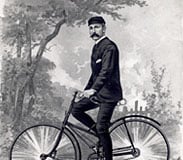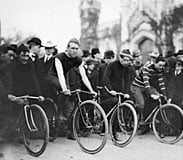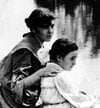By the end of the 19th Century, Chicago was an ideal location for the rise of a bicycle manufacturing empire. The city had a population of more than 1.5 million and nearly 2,000 miles of roads, many paved. The development of parks and tree-lined streets a short distance from the overcrowded tenement neighborhoods provided riders with a cycling sanctuary. In addition, changes in the design of the bicycle transformed cycling from a high-class form of leisure to a recreation available to a diversity of men and women. The average bicycle price also dropped as the sport became more popular and bike technology advanced. While a high-wheel bicycle could run as much as $300 during the 1870s – nearly one years wages for the average worker – by the end of the 19th Century a bargain hunter could find a "good used" or "shopworn" model for as little as $35. Chicago was also an industrial paradise – an ideal location for production and shipping.
By the 1890s, Chicago was the bicycle manufacturing capital of America. Eighty-eight local companies produced nearly two-thirds of the nations bicycles. Chicago was home to Century Cycle Manufacturing Company, James Cycle Company, Western Wheel Works, and Sterling Cycle Works. These factories flooded the streets of Chicago with Arrows, B&As, Black Hawks, Cinchs, and Sterlings. Sterling Cycle Works made headlines when Annie Kopchovsky, a Jewish mother of three, became the first women to cycle around the world on her Chicago-made Sterling brand bicycle.
Despite the large number of bicycle factories that were scattered across city, one Chicago bike manufacturer became an American icon. In 1890, a young German entrepreneur named Ignaz Schwinn came to the United States to make his fortune in the booming Chicago bicycle manufacturing industry. Within five years he partnered with meatpacker Adolph Arnold and incorporated Arnold, Schwinn & Company. The same year, the company released the Roadster. Arnold, Schwinn & Companys first product was a 19-pound, single-speed, recreational bicycle, but by 1895, Schwinn became known for its high-speed racing bikes. During the 1920s, Schwinn begins to focus not only on the quality of their bicycles but also on appearance. The 1934 Schwinn Aerocycle was designed to resemble airplanes, streamlined automobiles, and motorcycles. In 1948, Schwinn introduced the Black Phantom, which became an instant American classic. The popularity of the Phantom was soon surpassed by the 1963 Sting-Ray. The Sting-Rays high-rise handlebars and banana seat soon become the most popular features in bicycle design. (ibid.) Schwinn continued to manufacture American bicycles from the West Side of Chicago until 1993, when the company relocated to Colorado.
Today, the majority of the nations bicycles are produced outside of the United States. China, India, the EU, Taiwan, and Japan represent 87 percent of the global market, with China responsible for the production of 60 percent of the worlds bicycles. Eighty-six percent of bikes sold in the United States are imports from China. Although cyclists today are less likely to ride along the lakefront path on a locally produced bike, Chicago will always be an important part of bicycle manufacturing history.






















